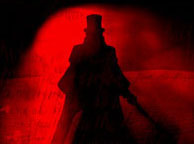Jack the Ripper

Book and Lyrics by Ron Pember and Denis de Marne
Music by Ron Pember
Director/scenery/costumes: Reginald Woolley;
Pianos: Geoffrey Brawn
and Tim Higgs
Musical Director: Tim Higgs
Scenic Design Doreen Hermitage
Players' Theatre, London - 25 June, 1974 (season)
Produced at the Ambassadors Theatre, London, 17th September, 1974. Transferred
to the Cambridge Theatre 17th February, 1975. Closed 12 April, 1975 (228
perfs)
Synopsis
The play is a musical reconstruction of incidents relating to the East End murders which took place between Friday, August 31st and Friday, November 9th, 1888. A solution of Jack the Ripper's identity is hinted at, but the play is an atmospheric commentary rather than an historical re-enactment, shifting between reality and artificiality, with characters representing "real" people as well as members of the music hall audience and players. It is an essential feature that some characters are called upon to play more than one role. They thus have a life within the Music Hall and also in reality. The Chairman also plays the authoritative roles of Sir Charles Warren, the Magistrate, and the Dock's Foreman, while Montague Druitt is also known as Toynbee and plays the villain in the melodrama and the magician.
For the chorus
The chorus are on stage for much of the play, being involved both as the audience in the Music Hall scenes and as inhabitants of Whitechapel.
Singing Principals
Polly, Marie, Annie, Lizzie, Martha. The Chairman and Police Sergeant Coles.
Other Principals
Montague, Daniel, Dinky, Bluenose, Slop and Lord Overcoat.
Original Cast:
(Character name in italics)
- Marie Kelly - Terese Stevens
- Lizzie Stride - Eleanor McCready
- Annie Chapman - Maria Charles//Elaine Holland
- Polly Anne Nicholls - Linda Rusby
- Liza Pearl - Bernice Adams
- Martha Tabram - Christine Edmonds
- Catherine Eddowes - Adrienne Frank//Sandra Holloway
- Frances Coles - Helena Chenel
- Montague Druitt - Ian Ruskin//Howard Southern
- Chairman - Peter Spraggon
- Daniel Mendoza - Roy Sone
- Dinky ninety-eights - Nigel Williams//Jonty Miller
- Blue Nose Stack - Mike Fields/Derek Connell
- Lord Overcoat - Gerald Taylor
- Police Sergeant Coles - John J. Moore/Charles West
- Morrie Abraham - Stanley Davis//out
- Wally Kingsnorth - John Denton
- Wilkie Harrington - Graham Richards
- Bertie Self - David Urwin//Alan C. Turvey
- add Bibby Beddoes - Harry Goodier
The Scenes
The fore-stage area represents a Victorian Music Hall with tables, chairs, and a table for the Chairman. Where possible this should be extended into the auditorium in order to link the Audience closely with the Music Hall scenes. Upstage of this is a raised area framed with a false proscenium decorated with lights, which are brought up when a Music Act is being performed. The area beyond represents the "real" streets of Whitechapel
Orchestration
Electric guitar, bass guitar and drums